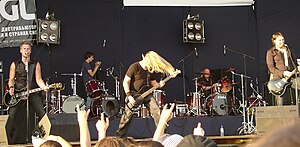Lake of Tears
| Lake of Tears | |
|---|---|

Lake of Tears at ProRock 2009 in Ukraine.
From left to right: Fredrik Jordanius, Mikael Larsson, Johan Oudhuis and Daniel Brennare. |
|
| Background information | |
| Origin | Borås, Sweden |
| Genres |
Gothic metal Doom metal Progressive metal |
| Years active | 1994–2000, 2003–present |
| Labels | Black Mark, Noise, Dockyard1 |
| Website | lakeoftears.net |
| Members |
Daniel Brennare Mikael Larsson Johan Oudhuis Fredrik Jordanius |
| Past members |
Jonas Eriksson Christian Saarinen Ulrik Lindblom Magnus Sahlgren |
Lake of Tears is a Swedish heavy metal band originally formed in 1994, generally considered to play gothic metal and doom metal. However, their sound has expanded to include psychedelic rock and progressive rock elements. The band broke up in 2000 amid creative differences, but reunited in late 2003, releasing the acclaimed album Black Brick Road. They released their eighth studio album, Illwill, in April 2011. In 2014 they released their first live album, By the Black Sea.
Lake of Tears was founded in the early 1990s by Daniel Brennare, Jonas Eriksson, Mikael Larsson and Johan Oudhuis. Their first album, entitled Greater Art, was released through the record label Black Mark Production in 1994. The album is doom metal featuring coarse, ragged vocals and crushing guitars. The band would subsequently steer away from such a directly categorized style, only revisiting it on their 2011 release Illwill.
Lake of Tears wowed critics and fans alike with their second recording, Headstones, released in 1995. The music underwent important changes, expanding on the riff-base of doom metal to achieve a more melodic and melancholic sound. The lyrics also explored new territory, intensely mournful and psychedelic fantasy imagery enhancing the album's heavy, autumnal soundscapes.
1997 brought the release of the band's most popular studio effort until then, A Crimson Cosmos. If Headstones had been a revision of their earlier sound, A Crimson Cosmos was a complete rebirth, being a hypnotically melodic album. The release's closing track, "A Crimson Cosmos", reflected a marked influence by progressive/psychedelic luminaries Pink Floyd, while other tracks, such as Lady Rosenred and Raistlin and the Rose reflected popular fantasy themes. Rhythm guitarist Jonas Eriksson had left the band before the release, being replaced by guitarist Ulrik Lindblom. After recording A Crimson Cosmos and touring with Lake of Tears until 1999, he also left the band and had to be substituted by Magnus Sahlgren, who played as lead guitarist, but only as a guest artist. Although he played on Forever Autumn and every subsequent Lake of Tears album, often composing the majority of lead guitar riffs, Sahlgren was only formally accepted as a band member following the release of 2004's Black Brick Road.
...
Wikipedia
